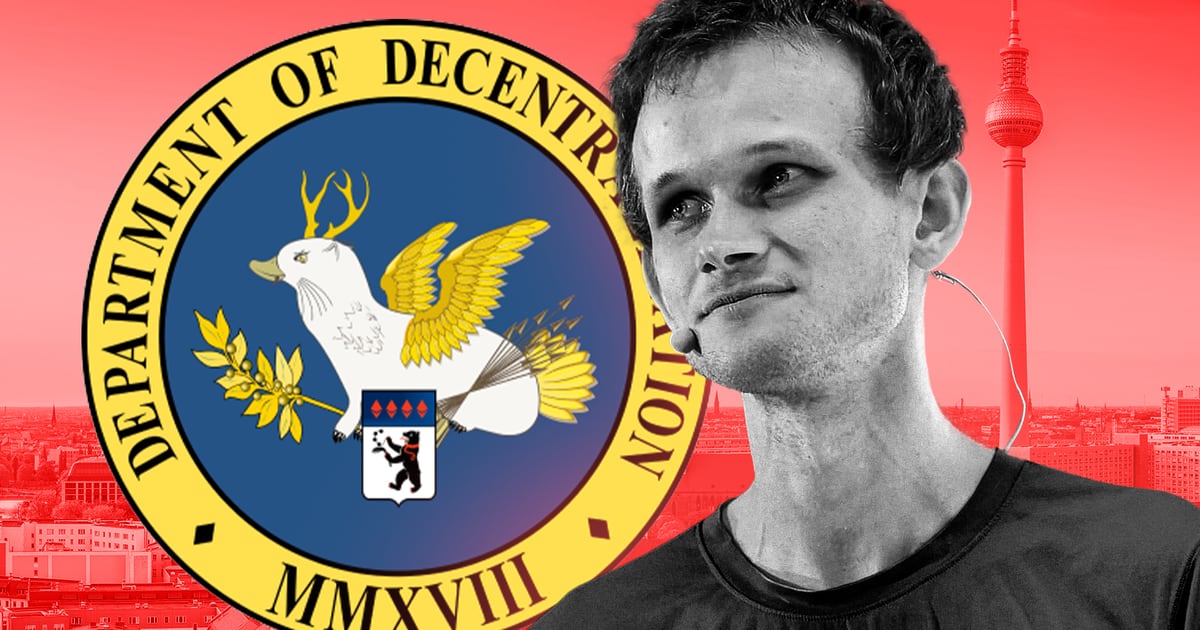Ethereum
Vitalik Buterin reveals five ways to rebuild Ethereum from scratch – DL News

- Ethereum architect shares his thoughts on smart contracts, EVM and other features.
- Buterin says Ethereum developers should have shipped proof of stake sooner.
- Ethereum is becoming more widespread with the advent of ETFs.
When 620 tired developers emerged after three days of non-stop coding at this year’s ETHBerlin event last week, few expected Vitalik Buterin to take the stage.
The co-founder and principal architect of Ethereum was a surprise guest.
What was even more surprising were some of his thoughts on building the second largest blockchain in the industry. Buterin detailed some of the regrets he had regarding Ethereum’s initial design.
For many listeners, his speech not only recalled the halcyon days of the network’s birth in 2014, but it also helped lay out the roadmap for the future of a cryptocurrency now worth $448 billion.
The United States has just approved an Ethereum spot exchange-traded fund, and BlackRock, the world’s largest asset manager, launched its own tokenized fund on the blockchain.
The Ethereum network has given rise to a vast ecosystem of developers and financial applications worth over 63 billion dollarsand it has become synonymous with decentralized finance.
List of things
Still, Buterin, a 30-year-old Canadian-Russian programmer, said he has a list of things he would have done differently. They range from the development of the Ethereum virtual machine to smart contracts and the Proof of Stake consensus mechanism.
And he noted that even as Ethereum becomes more widespread, it remains poorly understood.
Join the community to receive our latest stories and updates
“Bitcoin has a simple narrative which is digital gold,” Buterin said. “But like with Ethereum, it’s like ‘Whoa, what is Ethereum?'”
ETHBerlin04 in numbers
– 802 super humans in total
– 627 hackers
– 83 project submissions
– 56 volunteers
– 40 experienced hosts
– 33 judges
– 18 mentors
– 15 main teams
– 13 speakers
– around twenty dogs– ETHBerlin04 (@ETHBerlin) May 26, 2024
Sitting on comfortable sofas on stage with ETHBerlin organizers Afri Schoedon and Franziska Heintel, Buterin opened his conversation by sharing his fondest memories of the German capital over the years: hacking in the old office with the co-founders of ‘Ethereum Gavin Wood and Jeffrey Wilcke, launching Devcon. Zero, and celebrating Merge upgrade in 2022.
Then Schoedon asked the question.
“With everything you know and everything you have learned over the last 10 years, how would you build Ethereum differently today if you could start from scratch? asked Schoeden.
Too many songs, too soon
Buterin’s first qualm concerns Ethereum’s virtual machine, which is essential to operating the network as a kind of decentralized crypto megacomputer.
He explained that Ethereum’s original EVM design used 256-bit processing instead of 64 or 32 bits.
In computer architecture, computing size is measured in bits, with larger bits providing better efficiency and processing more data. But 256 bits are very inefficient for most operations and can create a lot of overhead on a blockchain, even for simple tasks.
For a network in its infancy, Ethereum did not need to be optimized for this.
“The original design was way too over-equipped for 256-bit,” Buterin told the audience.
Optimizing smart contracts
Second, Buterin said that early Ethereum developers should have focused on making it easier to write smart contracts with fewer lines of code.
The reason? Added transparency.
With fewer lines of code, he says, “people can properly see and verify what’s going on inside them.”
![]()
Switch to a “shittier” version of staking
Instead of custom computers – called miners – running non-stop to secure a blockchain network, Ethereum has moved to a different model.
Ethereum’s move from one Proof of work consensus mechanism – the way nodes in a blockchain like Bitcoin agree on the state of transaction data – to Proof of Stake in 2022 should have happened much earlier, Buterin said.
“When we moved to Proof of Stake, we should have been prepared to move to a slightly crappier version of Proof of Stake sooner,” he said. “We ended up wasting a lot of cycles really trying to make the proof of stake perfect.”
Instead of miners, Ethereum is now secured by validators who have staked 32 Ethereum, worth approximately $124,000, to do the same thing – and to be rewarded for it. If they behave badly by validating fraudulent transactions for example, they are punished.
In short, the shift replaced raw, energy-intensive computing power with economic incentives.
“We could have saved a huge amount of trees if we had a much simpler proof of stake in 2018,” Buterin said.
Issue logs from day one
From large token transfers to backdoor honeypots, users can track money in crypto quite easily. This is partly thanks to automatic logging.
But as the industry advances, including moving from external accounts like MetaMask to smart wallets like Safe, some aspects of this crucial logging are lost.
In particular, automatic logs for Ether transfers.
“It should have been there from the beginning,” Buterin said. “This could have taken about 30 minutes of coding for me, Gav and Jeff. Instead, it’s an EIP.
Ethereum Improvement Proposals are formal proposals made by developers to change certain aspects of the Ethereum network.
EIP-7708which Buterin submitted on May 17, would bring precisely this change.
![]()
Ditch Keccak
Buterin also said he would have used SHA-2 for Ethereum encryption rather than the current encryption called Keccak.
To understand the difference, you need to delve a little into the history of cryptography, particularly how SHA-3 became a standard. Remember, before crypto became synonymous with celebrity memecoins and nine-digit initial coin offerings, it was complicated math.
When Ethereum was built, the encryption used was “hash function competition” – yes, that’s a thing.
The National Institute of Standards and Technology held the competition to create a new hashing standard alongside SHA-2.
Previous standards had been attacked and debunked. But SHA-2 was unscathed and NIST was simply looking for a safe alternative. After all, variety is the spice of life (and apparently crypto).
Keccak was just one of many contestants who entered the competition. During the competition, the team made some minor changes to their algorithms, resulting in them being crowned the winner. In other words: SHA-3.
The first Ethereum team, however, had already implemented a non-standardized version of Keccak. Essentially, Ethereum uses a pre-SHA-3 iteration.
![]()
Big oops, right?
Well, that meant that Ethereum developers needed a custom library – collections of reusable code that didn’t need to be rewritten from scratch – to support both SHA-3 and Keccak.
“We are not compatible with other systems using SHA-3,” said Marius van der Wijden, one of Ethereum’s main developers. DL News. “We need to support both algorithms in the EVM.”
It’s basically resolved. Today, major libraries support both encryption mechanisms.
So yes, big whoop indeed.
“It does not matter in the grand scheme of things and the current development is certainly not affected by it,” van der Wijden said.
The Ethereum Crack Team
Despite the list of minor design errors, Buterin said it’s inevitable that any project will have a few.
“I am really very happy to feel that our core developers and their ability to execute continue to increase year after year,” he said.
“We are able to correct some of these errors efficiently and safely.”
Liam Kelly is a DeFi correspondent at DL News. Do you have any advice? Email to liam@dlnews.com.
Ethereum
Bits + Bips with Nic Carter: Trump’s Promises, Kamala’s Change, and ETH’s ‘Narrative Problem’

Nic Carter joins the show to talk about his journey to becoming a fighter, Trump’s promises, Lummis’ Bitcoin Reserve bill, the launch of ETH ETFs, and more.
Posted on July 31, 2024 at 12:00 PM EST.
Listen to the episode on Apple Podcasts, Spotify, Pods, Fountain, Podcast Addict, Pocket casts, Amazon Musicor on your favorite podcast platform.
In this episode of Bits + Bips, hosts James Seyffart, Alex Kruger, and Joe McCann dive with Nic Carter into Trump’s game-changing promises to the crypto community, Kamala Harris’ unexpected policy changes, and Solana’s explosive rise.
Additionally, Nic reveals his unexpected journey into amateur fighting and addresses the pressing issues surrounding Ethereum ETFs and the ecosystem he’s been funding the most lately.
Highlights of the show:
- Why Alex Thinks the Conference Was One of the Most Incredible Moments in Crypto History
- Nic’s reaction to Trump’s mention of deconstructing “Operation Chokepoint 2.0,” a term coined by Nic himself
- Nic’s Karate Fight and His Journey to Becoming an Amateur Fighter
- Why Nic Thinks There’s No Chance Lummis’ Bill Proposing the U.S. Government Establish a Strategic Bitcoin Reserve Will Pass
- The Importance of Trump’s Bitcoin Nashville Promises
- How Tether compares to the Eurodollar system
- What are the potential impacts of the Fed’s language at its next meeting?
- The implications of Harris’ campaign to mend ties with cryptocurrency companies
- How the ETH ETF Launch Happened and Why Nic Says Ethereum Has a “Narrative Problem”
- How Solana Has Been Heartbreaking Lately and Joe’s Response to Some of the Criticism
- How Nic, as a VC, sees the ETH vs. SOL debate and how founders are increasingly choosing Solana
Hosts:
Guest
- Nic CarterGeneral Partner at Castle Island Ventures
Connections
Bitcoin Conference:
- Trump’s speech:
- Lummis Proposal:
- Democrats/Harris looking for a “reset”
- Letter From Democratic politicians to DNC chair to include crypto in Democratic party platform:
ETH ETF Launch:
Solana rocks:
Ethereum
Bitcoin, Ethereum in the red as markets crash on volatility

Bitcoin And Ethereumalong with the rest of the top 10 crypto assets by market cap, look gloomy Thursday morning.
At the time of writing, the Bitcoin Price is still below $65,000 and 2.2% lower than it was at this time yesterday, according to CoinGecko data. Things are worse for the Ethereum Priceor 3.7% lower than 24 hours ago at $3,185.22. The drop in ETH price is in line with that of Lido Staked Ethereum (stETH), a liquid Ethereum staking token.
Over the past day, falling prices led to the liquidation of $225 million worth of derivative contracts, according to Coin glass. And about half of them, or about $100 million, have been liquidated in the last 12 hours.
When a trader is liquidated, it means that their market position has been forcibly closed by an exchange or broker due to a margin call or insufficient collateral. Margin is especially relevant when it comes to leveraged positions, which allow traders to control a multiple of their deposit, such as opening a $10,000 position with only $1,000 in their account.
Now that Bitcoin has posted three consecutive days of losses, it is possible that the world’s oldest and largest cryptocurrency could sink even further, BRN analyst Valentin Fournier said in a note shared with Decrypt.
“For three consecutive days, Bitcoin has closed negative, with one-way trades showing limited resistance from the bulls. Ethereum had a slightly positive Monday with strong resistance from the bears who have gained over the past two days,” he wrote. “This momentum could push BTC down towards the $62,500 resistance or even the $58,000 territories.”
Looking ahead, Fournier said BRN’s strategy will be to “reduce exposure to Bitcoin and Ethereum and find a better entry point after the dip.”
All this despite the fact that Federal Reserve Chairman Jerome Powell’s comments on interest rates yesterday were generally perceived as being accommodating and indicates that the FOMC cut rates in September.
QCP Capital, a Singapore-based cryptocurrency trading firm, noted that the rally in stocks, which left the S&P 500 starting the day 1.6% higher than its Wednesday close, was not felt in cryptocurrency markets.
“Cryptocurrencies saw a massive selloff overnight and this morning,” the firm wrote in a trading note. “The market remains on edge, with traders paying close attention to daily ETH ETF outflows and further supply pressures from Mt Gox and the US government.”
Meanwhile, the rest of the major pieces are a mixed bag.
Solana (SOL) has dropped 7.2% since yesterday to $169.13. Things are even worse for its most popular meme coins. In the last 24 hours, popular meme coins Dogwifhat (WIF) have dropped 12% and BONK (BONK) has dropped 9%, according to data from CoinGecko.
Their dog-themed competitor and Ethereum OG Dogecoin (DOGE), the only meme coin in Coingecko’s top 10, has dropped nearly 4% since yesterday and is currently trading at $0.1205.
XRP (XRP) fell to $0.608, down 7% from the same time yesterday.
Binance’s BNB Coin (BNB) has kept pace with BTC and is currently trading at $571, down 2.4% since the same time yesterday. Toncoin (TON), the native token of The Open Network, has only fallen 0.4% over the past day.
There remain the stablecoins USDC (USDC) and Tether (USDT), both of which are stable because they maintain their 1:1 peg with the US dollar.
Ethereum
FOMC Holds Interest Rates Steady, Bitcoin and Ethereum Prices Fall

Chairman of the Federal Reserve Jerome Powell
Jerome Powell Jerome Hayden “Jay” Powell is an American lawyer and investment banker who has served as the 16th Chairman of the Federal Reserve since 2018. Finance recently hinted at a potential rate cut in September, sparking a sharp rise in the stock market. The tech-heavy Nasdaq 100 rose 3.3%, and the S&P 500 rose 2%. In contrast, Bitcoin (BTC) fell 1.3% to $66,088 and Ethereum (ETH) The global cryptocurrency market fell by 1.11% to $3,313. Over the past 24 hours, the global cryptocurrency market capitalization also decreased by 0.71% to $2.39 trillion.
Market analysts believe that the decline in cryptocurrency prices is a short-term decline. Despite a bear market, Bitcoin and other cryptocurrencies are showing bullish signals. Bitcoin is still struggling to break the $70,000 mark, but its performance in August, ahead of potential rate cuts, will be closely watched.
Federal Reserve remains stable
On July 31, the U.S. Federal Reserve concluded a two-day meeting of the Federal Open Market Committee (FOMC) by deciding to keep benchmark interest rates unchanged at 5.25%-5.50%. The move met Wall Street expectations and marked the eighth consecutive meeting without a rate change.
Towards a market rebound?
According to SantimentThe FOMC’s decision to maintain current interest rates led to an initial decline in cryptocurrency prices. Traders were hoping for a rate cut, which hasn’t happened since March 2020. A future rate cut could signal bullish trends for stocks and cryptocurrencies, potentially boosting markets for the remainder of 2024. Despite the initial sell-off, markets are likely to stabilize unless another major event impacts the cryptocurrency sector.
Bullish outlook, bearish sentiment
The aggressive buildup of rate hikes and rising negative investor sentiment could pave the way for a substantial market rally. Despite the anticipation surrounding the FOMC meeting, the impact on cryptocurrencies was limited as the rate pause had already been priced in.
Previous Fed decisions have had minimal impact on Bitcoin prices.
A look into the past & the future
Historically, FOMC actions affect all asset classes. In 2020 and 2021, Bitcoin and other altcoins soared when the Fed cut rates to zero, only to reverse course in 2022 when rates began to rise. Investors have since moved trillions of dollars into lower-risk assets, with money market funds amassing over $6.1 trillion, enjoying an average return of 5%.
Key indicators to monitor
Bitcoin’s immediate resistance is noted at $66,852, with support at $65,000. The Relative Strength Index (RSI) is signaling oversold conditions, suggesting further declines are possible if the price falls below $65,900.
Investors are now closely watching the FOMC meeting for clues about inflation and economic growth, which could influence Bitcoin’s next move. The interplay between the Federal Reserve’s decisions and market reactions will be crucial in determining the future trajectory of cryptocurrencies and traditional assets.
Read also : Why is Bitcoin price down today? Is a major correction imminent?
The Fed’s decision has caused a stir in the market. Will this impact your investment strategy?
Ethereum
Tron’s Justin Sun Hints Ethereum Selloff Could Happen Due to ETF Outflows

Justin Sun, the founder of Tron DAO, has hinted at a major Ethereum (ETH) selloff following a series of transactions that have garnered considerable attention. Sun has unlocked a significant portion of his ETH stash. Additionally, he has transferred some of this ETH to Poloniex, a major cryptocurrency exchange.
Justin Sun hints at massive Ethereum selloff
Observers were particularly intrigued by the movement of 1,768 ETH (worth about $5.9 million) unstaked by Lido, according to data from Peck Shield Alert. Additionally, the subsequent transfer of 810 ETH, valued at about $2.7 million, to Poloniex cryptocurrency exchange
raised speculation about a massive Ethereum selloff.
The Ethereum price crash in early July, which saw a 10% drop, further fueled speculation in the market. This slowdown contributed to an 8% drop in the global cryptocurrency market capitalization. Moreover, one of the most notable impacts was a potential $66 million loss for Justin Sun at the time.
According to a report by Spot On Chain, Sun’s vast network Ethereum The holdings were severely impacted by the market downturn on July 5. Between February and June 2024, Sun accumulated a substantial amount of Ether, totaling 361,137 ETH across three separate wallets.
His acquisitions included 169,604 ETH in February at an average price of $2,870, 176,117 ETH in April at $3,177, and 15,416 ETH in June at $3,474. Just one day before the significant price drop, Sun reportedly made a profit of $58 million from these holdings.
However, the market crash on July 5th turned those gains into a staggering $66 million loss. At the height of the crisis, the price of Ethereum fell below $2,800. Although it has since rebounded above $3,300 following the launch of new ETFs, this event triggered a “sell the news” reaction among investors.
Moreover, despite the rebound, the price of ETH has remained below the average value of Sun’s third acquisition. Therefore, the latest concerns about Ethereum selling are not unfounded. This could be a loss mitigation measure, as Sun usually holds his ETH tightly.
Read also : 21Shares Uses Chainlink to Verify Ethereum ETF Reserves
ETH ETF Fund Outflows
Adding to the intrigue, flows from Ether exchange-traded funds (ETFs) have been consistently negative. On Monday, July 29, Ethereum Spot ETFs saw outflows totaling $98.3 million. Additionally, Grayscale’s Ethereum Trust (ETHE) alone accounted for $210 million in outflows, accelerating the outflow streak.
However, notable inflows were seen at Blackrock, Fidelity, and Bitwise, recording $58.2 million, $24.8 million, and $10.4 million, respectively. Despite these mixed signals, the price of Ethereum has remained relatively stable. The price of Ether is currently fluctuating between $3,300 and $3,400.
Ethereum Liquidation Chart, Source: Coinglass
At the time of going to press, the ETH Price fell 1.04% to $3,325.16 on Tuesday, July 30 with a market cap of $401 billion. Additionally, a broader sell-off in Ethereum was seen in the market with long liquidations of $33.58 million, according to Coin glassMeanwhile, shorts liquidated about $6.87 million of positions.
Read also : Ethereum Client Releases Important Stability Patch Ahead of Pectra Upgrade
-

 Regulation11 months ago
Regulation11 months agoRipple CTO and Cardano founder clash over XRP’s regulatory challenges ⋆ ZyCrypto
-

 Regulation10 months ago
Regulation10 months agoNancy Pelosi Considers Supporting Republican Crypto Bill FIT21 – London Business News
-

 Videos11 months ago
Videos11 months agoCryptocurrency News: Bitcoin, ETH ETF, AI Crypto Rally, AKT, TON & MORE!!
-

 Regulation11 months ago
Regulation11 months agoBitcoin’s future is ‘bleak’ and ripe for regulation, says lead developer
-

 News8 months ago
News8 months agoAave Price Increases Following Whales Accumulation and V3.1 Launch
-

 Regulation8 months ago
Regulation8 months agoSouth Korea Imposes New ‘Monitoring’ Fees on Cryptocurrency Exchanges
-

 Regulation8 months ago
Regulation8 months agoA Blank Sheet for Cryptocurrencies: Kamala Harris’ Regulatory Opportunity
-

 Regulation8 months ago
Regulation8 months agoCryptocurrency Regulations in Slovenia 2024
-

 News11 months ago
News11 months agoThe trader earned $46 million with PEPE after reaching a new ATH
-

 Regulation10 months ago
Regulation10 months agoCrypto needs regulation to thrive: Tyler Cowen
-

 Blockchain11 months ago
Blockchain11 months agoSolana ranks the fastest blockchain in the world, surpassing Ethereum, Polygon ⋆ ZyCrypto
-

 Blockchain10 months ago
Blockchain10 months agoSolana Surpasses Ethereum and Polygon as the Fastest Blockchain ⋆ ZyCrypto


















